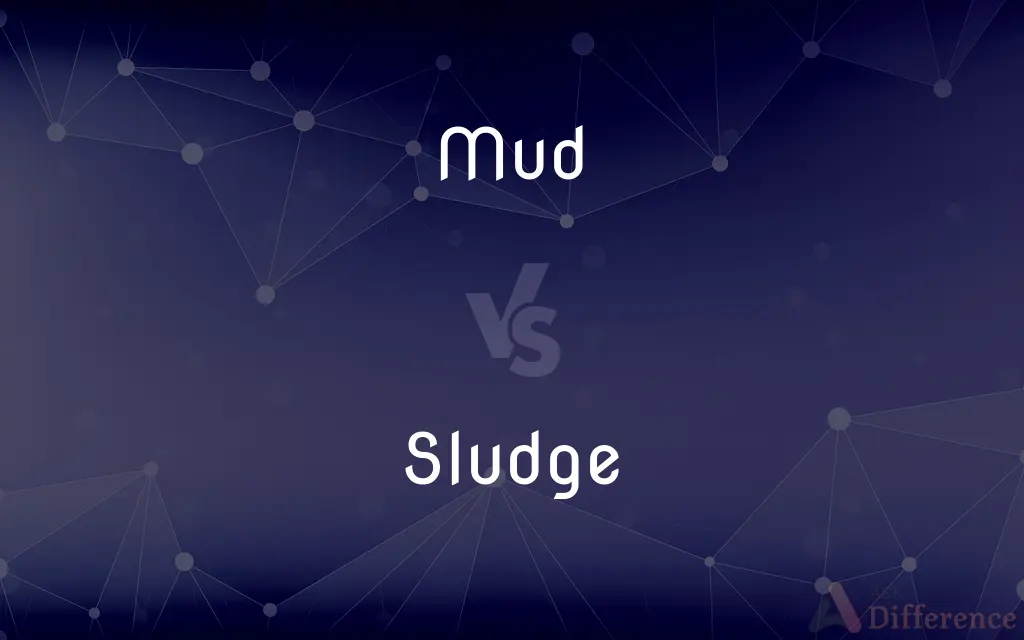Mud vs. Sludge — What's the Difference?
By Urooj Arif & Fiza Rafique — Updated on February 23, 2024
Mud is a mixture of water and soil or fine sediments, commonly found in natural settings, whereas sludge is a byproduct of industrial, agricultural, or wastewater treatment processes, containing more complex and often contaminated materials.

Difference Between Mud and Sludge
Table of Contents
ADVERTISEMENT
Key Differences
Mud is a natural blend that forms when water combines with soil, silt, or clay, resulting in a soft, sticky substance. It's often encountered in riverbeds, marshes, and other wet environments, playing a role in various ecological systems.
Sludge, in contrast, is not as naturally occurring as mud and is often the result of human activities. It's a semi-solid slurry that can emerge from the treatment of wastewater, industrial processes, and sewage, containing organic and inorganic materials, sometimes including hazardous substances.
Mud can be beneficial, serving as a habitat for organisms and a medium for plant growth, whereas sludge often requires treatment and disposal due to potential contaminants. The management of sludge is crucial for environmental protection and human health.
The composition of mud is relatively simple, primarily involving natural earth materials and water. Sludge, however, can be complex, with its content varying widely depending on its source, including chemicals, metals, and biological waste.
Understanding the distinction between mud and sludge is important in fields like environmental science, agriculture, and waste management, guiding how each substance is handled, utilized, or remediated for safety and sustainability.
ADVERTISEMENT
Comparison Chart
Origin
Natural environments
Industrial, agricultural, wastewater processes
Composition
Water and soil/sediments
Varied, including organic and inorganic materials
Ecological Impact
Often beneficial
Potentially harmful, requires treatment
Consistency
Soft, sticky
Semi-solid slurry
Usage
Ecological, recreational
Waste management, resource recovery
Compare with Definitions
Mud
A soft, sticky mixture of water and earth materials like soil and clay.
Children love to play in the mud after a rainstorm.
Sludge
A byproduct of water treatment processes, containing concentrated waste.
The treatment plant processes tons of sludge daily.
Mud
A habitat for various organisms in wetlands.
Many birds nest in the mud to lay their eggs.
Sludge
Accumulated sediment in tanks or containers, often needing removal.
Cleaning the sludge from the bottom of the fuel tank is a dirty job.
Mud
A challenge in outdoor activities like off-road racing.
The course was extremely tough due to the deep mud.
Sludge
A potential resource for energy or materials recovery.
Some companies convert sludge into biofuel.
Mud
Natural sediment that accumulates in aquatic environments.
The riverbed was covered in thick, slippery mud.
Sludge
A material requiring careful handling due to potential contaminants.
Handling sludge often requires protective gear to avoid exposure to toxins.
Mud
A material used in construction and pottery.
Mud bricks are a traditional building material in many cultures.
Sludge
Semi-solid residue from industrial or manufacturing processes.
The factory's sludge needs to be disposed of properly.
Mud
Mud is soil, loam, silt or clay mixed with water. It usually forms after rainfall or near water sources.
Sludge
Sludge is a semi-solid slurry that can be produced from a range of industrial processes, from water treatment, wastewater treatment or on-site sanitation systems. For example, it can be produced as a settled suspension obtained from conventional drinking water treatment, as sewage sludge from wastewater treatment processes or as fecal sludge from pit latrines and septic tanks.
Mud
Wet, sticky, soft earth, as on the banks of a river.
Sludge
Thick, soft, wet mud or a similar viscous mixture of liquid and solid components, especially the product of an industrial or refining process
The dumping of sewage sludge
Miscellaneous chemicals and treated sludges
Mud
A mixture of water and soil or fine grained sediment.
Sludge
A residual semi-solid material left from industrial, water treatment, or wastewater treatment processes.
Mud
Earth and water mixed so as to be soft and adhesive.
Sludge
Any thick messy substance
Mud
Water soaked soil; soft wet earth
Common Curiosities
Why is sludge considered a potential environmental hazard?
Sludge can contain hazardous substances like heavy metals and toxic chemicals, posing risks to ecosystems and human health.
How is sludge treated or disposed of?
Sludge treatment can include processes like digestion, dewatering, and incineration, followed by disposal or reuse in controlled environments.
Are there regulations governing sludge management?
Yes, there are strict regulations in many countries to ensure safe treatment, disposal, or reuse of sludge to protect public health and the environment.
Can mud have beneficial uses?
Yes, mud can be ecologically beneficial, supporting habitats and being used in construction and therapeutic applications.
Can mud be turned into sludge?
Mud can become sludge-like if contaminated with industrial waste or sewage, changing its composition and potential uses.
Can sludge be hazardous to human health?
Yes, sludge containing toxic substances can pose health risks through direct contact or contamination of water and food sources.
Is all sludge harmful?
Not all sludge is harmful; its hazard level depends on its source and composition, with some types being treated and reused beneficially.
What are the primary components of mud?
Mud primarily consists of water mixed with soil, silt, or clay.
Can mud be a source of pollution?
While generally natural, mud can become polluted by human activities, potentially leading to environmental issues.
What role does mud play in agriculture?
Mud can enrich soil with nutrients and minerals, supporting plant growth and agricultural productivity.
How does the consistency of mud differ from sludge?
Mud tends to be softer and more fluid, while sludge is typically a thicker, semi-solid slurry.
What are some common sources of sludge?
Common sources include wastewater treatment plants, industrial processes, and water treatment facilities.
How are mud and sludge similar?
Both can be mixtures of water and solids, but sludge is typically a byproduct of human activities and more complex in composition.
How does sludge impact water bodies?
Untreated sludge can pollute water bodies, harming aquatic life and contaminating water supplies.
Is it possible to recycle sludge?
Yes, recycling sludge into products like biofuel, compost, or building materials is possible with appropriate treatment.
Share Your Discovery

Previous Comparison
Scarlet vs. Crimson
Next Comparison
Jigsaw vs. PuzzleAuthor Spotlight
Written by
Urooj ArifUrooj is a skilled content writer at Ask Difference, known for her exceptional ability to simplify complex topics into engaging and informative content. With a passion for research and a flair for clear, concise writing, she consistently delivers articles that resonate with our diverse audience.
Co-written by
Fiza RafiqueFiza Rafique is a skilled content writer at AskDifference.com, where she meticulously refines and enhances written pieces. Drawing from her vast editorial expertise, Fiza ensures clarity, accuracy, and precision in every article. Passionate about language, she continually seeks to elevate the quality of content for readers worldwide.














































